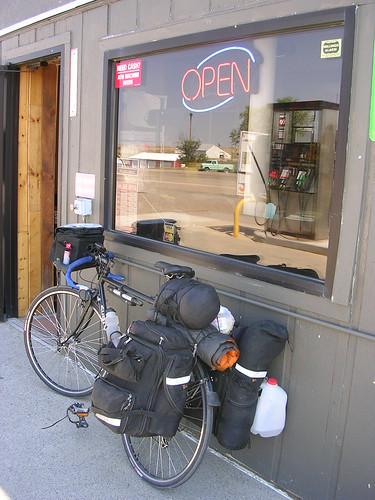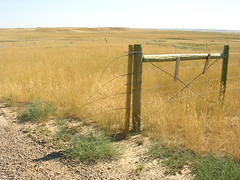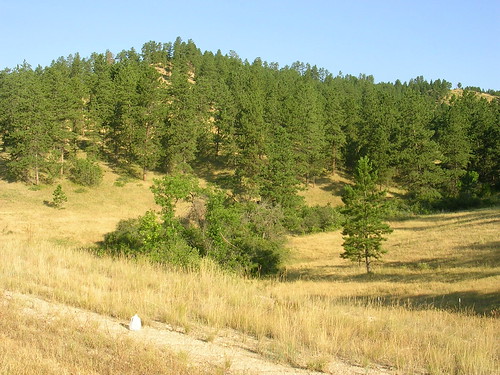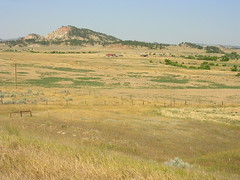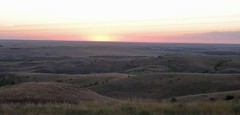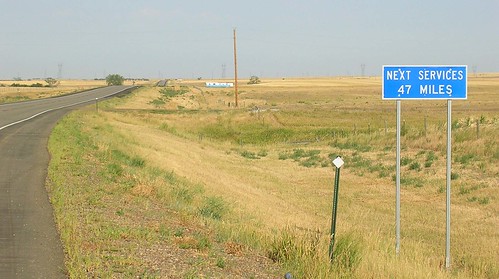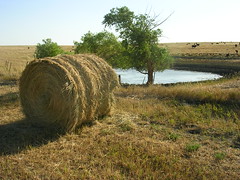Billings, MT -- So much has happened that this is going to be a two for one special. Lucky you. The next entry's below.
Northeasterner goes West
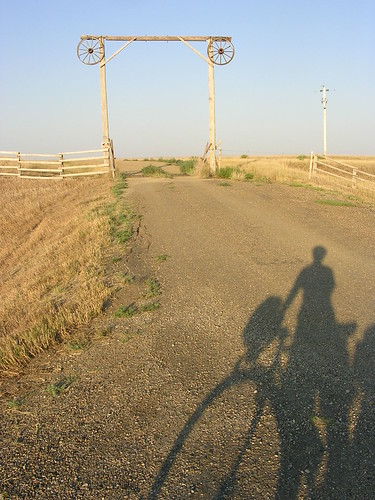 About the time I got to South Dakota, I realized that this is not the country I grew up in. There are no trees. Sometimes I see a town on the horizon and it takes me two hours to ride there. I see antelope by the road that I can identify only because I saw them in the computer game "Oregon Trail."
About the time I got to South Dakota, I realized that this is not the country I grew up in. There are no trees. Sometimes I see a town on the horizon and it takes me two hours to ride there. I see antelope by the road that I can identify only because I saw them in the computer game "Oregon Trail."
I find myself talking more and more about Massachusetts to people out here. In Massachusetts, you're always in a town and the interstates are four lanes in each direction, not four lanes total. In Massachusetts, we don't need to worry much about the whole landscape catching on fire or being snowed into our houses six miles from the road. In Massachusetts, you don't need to drive sixty miles to the grocery store, and the economy doesn't depend on the weather.
The distances out here make me nervous. Forty miles isn't unusually far between towns, and it's noteworthy if I see one or two houses in the course of the ride. There might be signs or gates for ranches, but those are usually miles off of the paved road so I never see them. I find myself a lot more concerned out here with getting to the next point on my map, whether it's a town or an intersection. Part of that is practical -- if I can't count on being able to fill up a water bottle for forty miles, I need to carry about ten pounds of water. Part of it, though, is just that I'm not used to geography like this. I can feel myself getting slightly anxious when I look around and the road I'm on and the fence I'm next to are the only signs I see of people.
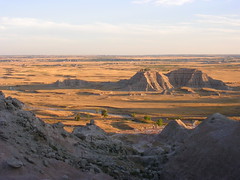 I thought about this a lot when I visited the Badlands back in South Dakota. The land there is bizarre and intimidating by any standards, and especially by mine. There are dry grasslands and then these peaks and rocky formations made of crumbly, dry soil and stone. Apparently the Badlands were formed by rivers, which cut all of these dramatic outcrops out of the sea bed. You can tell that they came from water -- there are canyons and little channels cut into the rocks, but the Badlands get less than 16 inches of rain a year. While I was there, it rained for five minutes and a ranger told me that was probably going to be it for precipitation this month. Walking around after the rain, I could barely tell it had happened. The ground was dry and cracked again.
I thought about this a lot when I visited the Badlands back in South Dakota. The land there is bizarre and intimidating by any standards, and especially by mine. There are dry grasslands and then these peaks and rocky formations made of crumbly, dry soil and stone. Apparently the Badlands were formed by rivers, which cut all of these dramatic outcrops out of the sea bed. You can tell that they came from water -- there are canyons and little channels cut into the rocks, but the Badlands get less than 16 inches of rain a year. While I was there, it rained for five minutes and a ranger told me that was probably going to be it for precipitation this month. Walking around after the rain, I could barely tell it had happened. The ground was dry and cracked again.
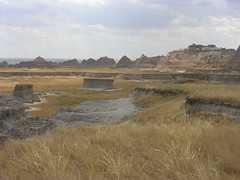 When I first arrived I thought he place must be aching for moisture, but it took me until the day I left to realize that it wasn't at all. It's those five minute rains that are not-so-slowly eroding the Badlands. They'll be gone entirely in 500,000 years. There are birds, toads, insects, and plants. It's actually doing fine without the water I've come to expect and associate with a healthy earth.
When I first arrived I thought he place must be aching for moisture, but it took me until the day I left to realize that it wasn't at all. It's those five minute rains that are not-so-slowly eroding the Badlands. They'll be gone entirely in 500,000 years. There are birds, toads, insects, and plants. It's actually doing fine without the water I've come to expect and associate with a healthy earth.
To put it simply, this is not New England. My ideas about land and landscapes no longer apply. Out here, I'm usually so awestruck by the hugeness of the places I see that I don't actually see much of what's in them. I spent a wonderful day with a guy that I met in Alzada, MT, and he drove me around the Black Hills and Northeastern Wyoming showing me the sights. He pointed things out to me at great distances -- cows, deer, antelope -- that I usually couldn't see at all. At first I thought it was my eyesight but I think it's actually the way my eyes are trained. How can I see a deer when I'm trying to process a view that includes a massive sky and a horizon that could be twenty miles away? As we drove, I could feel myself getting more and more used to it, but he still said things sometimes that reminded me I was in a very different place. If someone responds to a 911 call in an hour, that's really pretty fast. He went to high school 35 miles from home.
I'll be here for a while -- it's big out here -- but I still may not have adjusted to the prairie by the time I hit the mountains. It's different. Life is different. I'm glad to be getting to see it. Right now I'm in Billings, staying with a RAGBRAI connection, and I'm going to see my first rodeo tonight. Then on towards the Rockies. Onwards and upwards, in the most literal sense.
White Girl in Indian Country
Billings, MT -- I picked up a pretty good book, Neither Wolf nor Dog at a Lakota museum's gift shop in South Dakota. It's kind of a novel, kind of an oral history project, and quite readable -- I'd recommend it. It's got me thinking about passing through these reservations. So here's what I've been thinking going through Indian Country, right, wrong, ignorant, or whatever it is.
Every time I come near an Reservation, white people start warning me about it. They tell me not to spend the night there, to be careful riding through. Have I thought about taking another road that goes around? I'll probably be fine, they say, but don't ride through on a weekend and just don't spend the night. Be careful. There's a lot of unemployment in those parts, they tell me, and that means people have more time to get into trouble.
I don't know if they have any reason to say those things. I'm skeptical, because isn't that what white people say about ethnic neighborhoods all over the country? But I'm wary, because I'm not from here and the all I know about the places I go is what people tell me. Maybe traveling by myself on a bicycle isn't the best time to try to test the line between caution and prejudice, I tell myself.
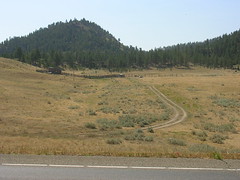 So I stopped just short of the Northern Cheyenne Reservation on Wednesday, rather than ride another 20 miles to the reservation town of Lame Deer, and spent the night in Ashland, MT. Even there, people made me nervous. I was told not to camp in the city park or almost anywhere else in town because of safety concerns -- people get drunk and are out at night around here, I was told. I ended up camping on a nice woman's lawn before setting off to ride across the Northern Cheyenne and Crow reservations on Thursday.
So I stopped just short of the Northern Cheyenne Reservation on Wednesday, rather than ride another 20 miles to the reservation town of Lame Deer, and spent the night in Ashland, MT. Even there, people made me nervous. I was told not to camp in the city park or almost anywhere else in town because of safety concerns -- people get drunk and are out at night around here, I was told. I ended up camping on a nice woman's lawn before setting off to ride across the Northern Cheyenne and Crow reservations on Thursday.
The road towards Lame Deer went up an awfully big ridge almost as soon as I started. It took me about an hour to go the five miles up it, and I was sweating, grumpy, and trying to catch my breath at the peak when a car pulled over to talk to me. There were three men in it, and the driver was very friendly. He introduced himself, said he was from Lame Deer, and I chatted with the three of them about my trip. He had relatives in Massachusetts, and he and his younger passengers started telling me about the road ahead. The worst of the climb was over, they said, and I was glad to hear it. I had a big downhill into Lame Deer to look forward to, and then rolling hills most of the rest of the way.
The driver also told me that if I took the next gravel road on my right, I'd take a loop past some ice wells, where the water stayed frozen all year. A little further down the road was Crazy Head Springs, where there was a Cheyenne Language Immersion program and a great spring. He told me that Cheyenne water was good water, and that if I took some and took it with me it would get me where I was going. The other two men in the car laughed at that, and he said that they didn't believe it, but that I should get some water anyway. He told me his name again and said that I should tell people in Lame Deer I knew him. They'd treat me well, he said.
It was just what I needed after that climb -- a talk with some locals and the prospect of some neat sights off the beaten path. It lifted my spirits. As I turned down the gravel road, something started in my head. Somewhere in the unwritten handbook for solo female travelers there is probably a line that specifically advises against going down bumpy gravel roads that no one knows you're taking (except three strange men you've just met) in an area that people have told you is unsafe. I kept riding, though. I didn't want to pre-judge the reservation, and I've found that tips from locals usually lead me to cool places to explore.
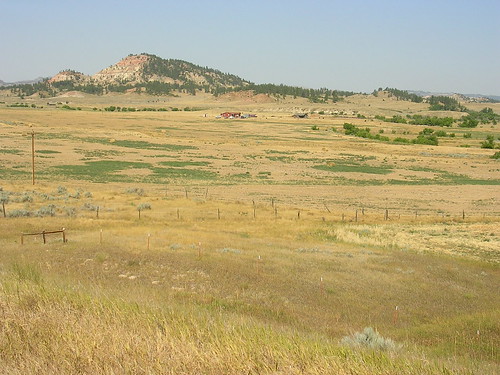 I came to some cows and saw two people on horseback riding on a hill with the rest of the herd. They must have seen me, but didn't acknowledge the probably unusual sight of a white girl on a loaded bicycle coming down their road. They were too far away to call out to, but I found myself wanting to yell my friend in the car's name to them, and tell them that I had been invited. Instead, I turned around and rode back to the road. Perhaps despite the invitation, this was not my country to explore. There are plenty of other roads out there, already stolen, for me to ride down without invading a cattle pasture on Native land.
I came to some cows and saw two people on horseback riding on a hill with the rest of the herd. They must have seen me, but didn't acknowledge the probably unusual sight of a white girl on a loaded bicycle coming down their road. They were too far away to call out to, but I found myself wanting to yell my friend in the car's name to them, and tell them that I had been invited. Instead, I turned around and rode back to the road. Perhaps despite the invitation, this was not my country to explore. There are plenty of other roads out there, already stolen, for me to ride down without invading a cattle pasture on Native land.
Or was I just scared? Maybe. By the time I got to the turn off for Crazy Head Springs I had convinced myself that I was just scared of those horsemen's anger or disapproval. Crazy Head had a sign on the highway, and there was that school I could look for. I could explain myself to someone, drop the driver's name, get some water, and then continue my ride. No reason to be scared. No reason to believe that the reservation was any more threatening than anywhere else. No reason to treat the place or the people with anything other than my usual friendly and open approach.
I took the turn down a dusty dirt road and got to the sign for the school, which was directly after a sign informing visitors that non-members of the tribe needed a permit from an office in Lame Deer. I was thinking about whether it was more oblivious to go get a permit or to wander around without one when I realized that the most oblivious thing I could think of doing would be to show up asking, in English, for special water at a Native language immersion school. I turned around again.
 I think there is a reason to treat the reservations differently, but it doesn't have to be fear. My usual approach to people -- friendly, open -- assumes that I'm entitled to be there talking to them, and though this whole country is stolen land I'm not entitled to explore, I'm especially not entitled to explore these reservations.
I think there is a reason to treat the reservations differently, but it doesn't have to be fear. My usual approach to people -- friendly, open -- assumes that I'm entitled to be there talking to them, and though this whole country is stolen land I'm not entitled to explore, I'm especially not entitled to explore these reservations.
The ride into Lame Deer was all down hill, like they said. I bought a liter of Aquafina at the grocery store, chatted with and old man outside, and stayed on the highway until I was out of the Northern Cheyenne and the adjacent Crow reservation, fifty miles later.
